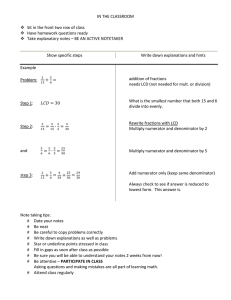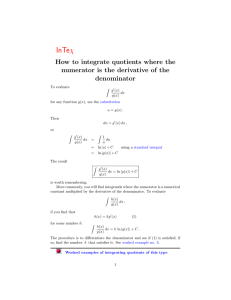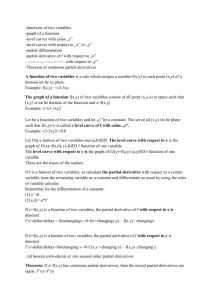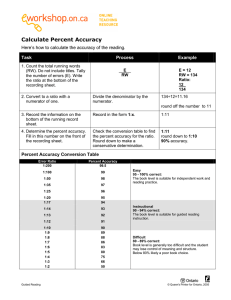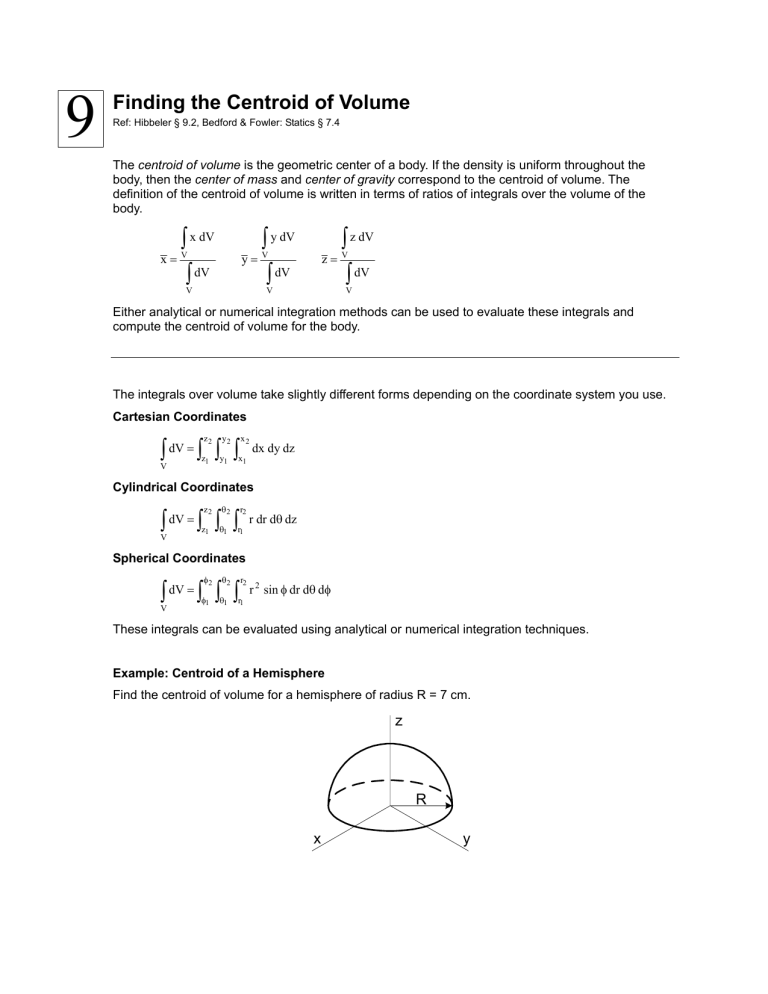
9
Finding the Centroid of Volume
Ref: Hibbeler § 9.2, Bedford & Fowler: Statics § 7.4
The centroid of volume is the geometric center of a body. If the density is uniform throughout the
body, then the center of mass and center of gravity correspond to the centroid of volume. The
definition of the centroid of volume is written in terms of ratios of integrals over the volume of the
body.
x=
∫ x dV
V
∫
y=
dV
V
∫ y dV
V
∫
z=
dV
V
∫ z dV
V
∫ dV
V
Either analytical or numerical integration methods can be used to evaluate these integrals and
compute the centroid of volume for the body.
The integrals over volume take slightly different forms depending on the coordinate system you use.
Cartesian Coordinates
z2
y2
x2
z1
y1
x1
∫ dV = ∫ ∫ ∫
V
dx dy dz
Cylindrical Coordinates
z2
θ2
r2
z1
θ1
r1
∫ dV = ∫ ∫ ∫
V
r dr dθ dz
Spherical Coordinates
φ2
θ2
r2
φ1
θ1
r1
∫ dV = ∫ ∫ ∫
V
r 2 sin φ dr dθ dφ
These integrals can be evaluated using analytical or numerical integration techniques.
Example: Centroid of a Hemisphere
Find the centroid of volume for a hemisphere of radius R = 7 cm.
z
R
x
y
Note: This simple example will allow us to check our results against published values. For example,
Hibbeler shows (inside back cover) that the centroid for a hemisphere resting on the plane formed by
the x and y axes to be located at x = 0, y = 0, z = 3/8 R.
Solution: Numerical Integration
The volume of the hemisphere can be calculated by using the equation for the area of a circle, and
integrating in only one direction, z.
To use this approach, first note that the area of the base is easily calculated, as A = π R2.
z
A = π R2
x
y
The area of the circle formed by any x-y plane through the hemisphere is calculated as a = π r2.
z
a = π r2
r
r
z
z
x
R
y
where the value of r depends on z. The relationship between r and z is readily determined, since r
and z are two sides of a right triangle in which the hypotenuse is the radius of the hemisphere, R.
r = R 2 − z2
We then integrate the area of the circle from z = 0 to z = R.
∫
V = dV =
V
∫
R
z =0
a dz =
∫ (π r ) dz = ∫
R
z =0
2
R
z =0
(
)
π R 2 − z 2 dz
To approximate the result using numerical integration methods, rewrite the integral as a sum and the
dz as a ∆z. Graphically (for the volume calculation in the denominator) this is equivalent to
approximating the volume of the hemisphere by a series of stacked disks of thickness ∆z. One such
disk is shown in the figure below.
z
Vi = π ri2 ∆z
ri
x
∆z
zi
y
Here, the value of r at the current (point “i”) value of z has been used to calculate the volume of the
disk. Since R = 7 cm in this example, we might try a ∆z of 1 cm, and calculate the volumes of seven
disks (N = 7). For each disk, the value of zi can be calculated using
z i = i ∆z
The value of the corresponding radius is then
ri = R 2 − z i 2
The formula for volume can then be written in terms of z, as
(
)
Vi = π R 2 − z i 2 ∆z
The sum of all of the volumes of all seven disks is an approximation of the volume of the hemisphere.
∑
∑ π [R
N
N
V≈
Vi =
i =1
2
]
− (i ∆z )2 ∆z
i =1
In MATLAB, this calculation looks like this:
» R = 7;
%Raidus
» N = 7;
%Number of intervals
» deltaZ = R/N;
%Interval spacing
» %Sum (pi * (R^2 - (i*deltaZ)^2) * deltaZ) for i = 1,2,...,N
» V_predicted = 0;
%Initialize predicted volume to zero
» for i = 1:N
V_predicted = V_predicted + pi * (R^2 - (i*deltaZ)^2) * deltaZ;
end
» V_predicted
V_predicted =
637.7433
We can see how good (or bad) the approximation is by calculating the actual volume of the
hemisphere.
V_actual = 2/3 * pi * R^3
V_actual =
718.3775
The approximation using only seven disks is not too good. If we use more disks, say N = 70, the
approximation of the volume is quite a bit better.
» R = 7;
%Raidus
» N = 70;
%Number of intervals
» deltaZ = R/N;
%Interval spacing
» %Sum (pi * (R^2 - (i*deltaZ)^2) * deltaZ) for i = 1,2,...,N
» V_predicted = 0;
%Initialize predicted volume to zero
» for i = 1:N
V_predicted = V_predicted + pi * (R^2 - (i*deltaZ)^2) * deltaZ;
end
» V_predicted
V_predicted =
710.6440
To calculate the centroid using numerical methods, simply replace the ratio of integrals by the
numerical approximation:
z=
∫
V
∫
dV
∑ z π [R
N
z dV
≈
V
i =1
N
∑ π [R
i =1
2
2
]
− (i ∆z )2 ∆z
]
− (i ∆z )2 ∆z
The extra “z” has been included in the numerator as (I * deltaZ). In MATLAB, the calculation of the
centroid looks like this:
» numerator = 0;
%Initialize numerator to zero
» denominator = 0;
%Initialize denominator to zero
» for i = 1:N
%Sum both numerator and denominator
numerator = numerator + (i*deltaZ) * pi * (R^2 - (i*deltaZ)^2) * deltaZ;
denominator = denominator + pi * (R^2 - (i*deltaZ)^2) * deltaZ;
end
» z_bar = numerator / denominator
z_bar =
2.6530
We can use the analytical result to check our answer.
» z_bar_act = 3/8 *R
z_bar_act =
2.6250
Annotated MATLAB Script Solution
%%%%%%%%%%%%%%%%%%%%%%%%%%%%%%%%%%%%%%%%%%%%%%%%%%%%%%%%%%%%%%%%%%%%%%%%%%
%Define the System
%%%%%%%%%%%%%%%%%%%%%%%%%%%%%%%%%%%%%%%%%%%%%%%%%%%%%%%%%%%%%%%%%%%%%%%%%%
R = 7;
%Radius
N = 70;
%Number of disks
deltaZ = R/N;
%Calculate disk thickness
fprintf('SYSTEM\n')
fprintf('Raidus = %3.1f cm\t\tN = %3.0f\t\tdeltaZ = %3.2f\n\n',R,N,deltaZ)
%%%%%%%%%%%%%%%%%%%%%%%%%%%%%%%%%%%%%%%%%%%%%%%%%%%%%%%%%%%%%%%%%%%%%%%%%%
%Calculate the Volume
%%%%%%%%%%%%%%%%%%%%%%%%%%%%%%%%%%%%%%%%%%%%%%%%%%%%%%%%%%%%%%%%%%%%%%%%%%
%Sum (pi * (R^2 - (i*deltaZ)^2) * deltaZ) for i = 1,2,...,N
V_predicted = 0;
%Initialize predicted volume to zero
for i = 1:N
V_predicted = V_predicted + pi * (R^2 - (i*deltaZ)^2) * deltaZ;
end
fprintf('CALCULATE THE VOLUME\n')
fprintf('Predicted Volume = %3.3f cm^3\n',V_predicted)
V_actual = 2/3 * pi * R^3;
fprintf('Actual Volume = %3.3f cm^3\n\n',V_actual)
%%%%%%%%%%%%%%%%%%%%%%%%%%%%%%%%%%%%%%%%%%%%%%%%%%%%%%%%%%%%%%%%%%%%%%%%%%
%Calculate the Centroid
%%%%%%%%%%%%%%%%%%%%%%%%%%%%%%%%%%%%%%%%%%%%%%%%%%%%%%%%%%%%%%%%%%%%%%%%%%
numerator
= 0;
%Initialize numerator to zero
denominator = 0;
%Initialize denominator to zero
for i = 1:N
%Sum both numerator and denominator
numerator
= numerator + (i*deltaZ) * pi * (R^2 - (i*deltaZ)^2) *
deltaZ;
denominator = denominator + pi * (R^2 - (i*deltaZ)^2) * deltaZ;
end
z_bar = numerator / denominator;
fprintf('CALCULATE THE CENTROID\n')
fprintf('Calculated z_bar = %3.3f cm\n',z_bar)
z_bar_act = 3/8 *R;
fprintf('Actual z_bar = %3.3f cm\n',z_bar_act)

